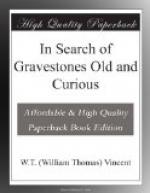[Transcriber’s note: inscriptions below enclosed in a border]
Eduard Schmidt
Geb d. 8 Oct., 1886.
Gest d. 10 Jan., 1887.
This I copied in the cemetery at Schaffhausen. But at Hendon, a north-west suburb of London, has recently been placed against the church wall a still simpler memorial, a small slab of marble, inscribed:
Carl Richard Loose
B. 21. 1. 52: D. 14. 10. 81.
For brevity in excelsis the following, from the cemetery at Heidelberg, can hardly be eclipsed:
Michael Seiler
1805.—1887.
Sometimes the asterisk is used by the Germans to denote birth, and the dagger (or cross) for death, thus:
Hier Risht in Gott
Natalie Brethke
* 1850 +- 1884
CHAPTER XIII.
VERY OLD GRAVESTONES.
Although, for reasons already explained or surmised, the gravestones in our burial-grounds seldom exceed an age of 200 years, there has probably been no time and no race of men in which such memorials were unknown. Professor Dr. John Stuart, the Scottish antiquary,[15] opines that “the erection of stones to the memory of the dead has been common to all the world from the earliest times,” and there are many instances recorded in the Old Testament, as when Rachel died and Jacob “set a pillar upon her grave” (Genesis, chapter xxxv. verse 20); and another authority, Mr. R. R. Brash,[16] in a similar strain, comments on the sentiment which appears to have been common to human nature in all ages, and among all conditions of mankind, namely a desire to leave after him something to perpetuate his memory, something more durable than his frail humanity. This propensity doubtless led him in his earliest and rudest state to set on end in the earth the rough and unhewn pillar stone which he found lying prostrate on the surface, and these hoar memorials exist in almost every country.
[Footnote 15: “The Sculptured Stones of Scotland” (two volumes), by John Stuart, LL.D., Secretary to the Scottish Society of Antiquaries.]
[Footnote 16: “Ogam Inscribed Monuments,” by R.R. Brash; edited by G.M. Atkinson.]
A remarkable instance is afforded by Absalom, the son of David, who himself set up a stone to record his memory: “Now Absalom in his lifetime had taken and reared up for himself a pillar, which is in the king’s dale: for he said, I have no son to keep my name in remembrance: and he called the pillar after his own name: and it is called unto this day, Absalom’s place” (2 Samuel, chapter xviii. verse 18).




